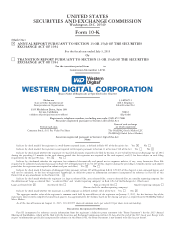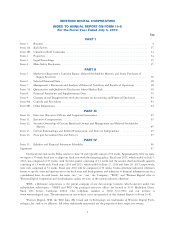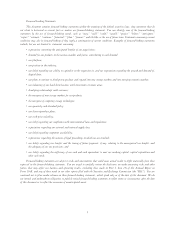Western Digital 2015 Annual Report Download - page 15
Download and view the complete annual report
Please find page 15 of the 2015 Western Digital annual report below. You can navigate through the pages in the report by either clicking on the pages listed below, or by using the keyword search tool below to find specific information within the annual report.we offer HDDs that provide high quality, reliable storage for backup and capacity expansion in both mobile and desktop
form factors that are designed to keep digital content secure while providing portable storage for desktops and notebooks.
In addition, within branded products we offer solutions for SMBs, by offering complete network storage solutions
designed to meet the needs of SMBs by providing centralized storage, backup, data protection and remote file access. We
also provide external hard drives that connect to home or office networks, enabling consumers access from anywhere with
an Internet connection and from smart phones, tablets and PCs via WD mobile apps and PC software. These My Cloud
solutions offer the same functionality as public cloud storage services, yet offer consumers the peace of mind that owner-
ship brings, with lower cost and greater capacity. Certain branded product solutions-such as our My Cloud products
include software that assists customers with backup, remote access and management of digital content.
Our branded product hard drive unit shipments were 25 million in each of 2015, 2014 and 2013.
Consumer Electronics Solutions. CE solutions are used in DVRs, gaming consoles, security surveillance, systems, set top
boxes, camcorders, multi-function printers and entertainment and automobile navigation systems. Our CE solutions include
HDDs designed and optimized for video streaming and continuous digital video recording. These HDDs deliver quiet
operation, low operating temperature, low power consumption, high reliability and optimized streaming capabilities. Our
CE HDD unit shipments were 37 million, 37 million and 28 million for 2015, 2014 and 2013, respectively.
Technology
Hard Disk Drives
HDDs provide non-volatile data storage, which means that the data remains present when power is no longer
applied to the device. The primary measures of hard drive performance include:
‰Acoustics — sound power emitted during hard drive operation, commonly expressed in decibels, and perceived
loudness due to sound pressure, commonly expressed in sones;
‰Data transfer rate — sustained rate of data transfer to and from the disk, commonly expressed in gigabits per
second;
‰Power consumption — which is the amount of electricity required to operate the drive, measured in watts;
‰Seek time — time needed to position the heads over a selected track on the disk surface, commonly expressed
in milliseconds;
‰Spindle rotation speed — nominal rotation speed of the disks inside the hard drive, commonly expressed in
RPM or latency. Spindle rotation speeds commonly stated as 5,400, 7,200, 10,000 and 15,000 RPM are some-
times approximations; and
‰Storage capacity — which is the amount of data that can be stored on the hard drive, commonly expressed in
GB or TB.
The storage capacity of a hard drive is determined by the number of disks and each disk’s areal density (track
density multiplied by bit density), which is a measure of the amount of data that can be stored on the recording sur-
face of the disk per unit area. Head and magnetic media technologies are two of the key technology components of
hard drives affecting areal density. We develop and manufacture a substantial portion of the heads and magnetic
media used in our hard drive products. As areal density increases, achieving a given drive capacity potentially reduces
product costs over time through reduced component requirements. We also invest considerable resources in research
and development, manufacturing infrastructure and capital equipment of head and magnetic media components in
order to secure our competitive position and cost structure.
Industry-standard interfaces allow the drives to communicate with the host system. The primary interface for
PCs is SATA and the primary interfaces for enterprise systems are Fibre Channel, SAS, SATA and PCIe.
Solid-State Drives
SSDs use semiconductor, non-volatile media, rather than magnetic media and magnetic heads, to store and allow
fast access to data without any moving parts. The cost per bit of solid-state drives is more expensive than hard drives,
9
























